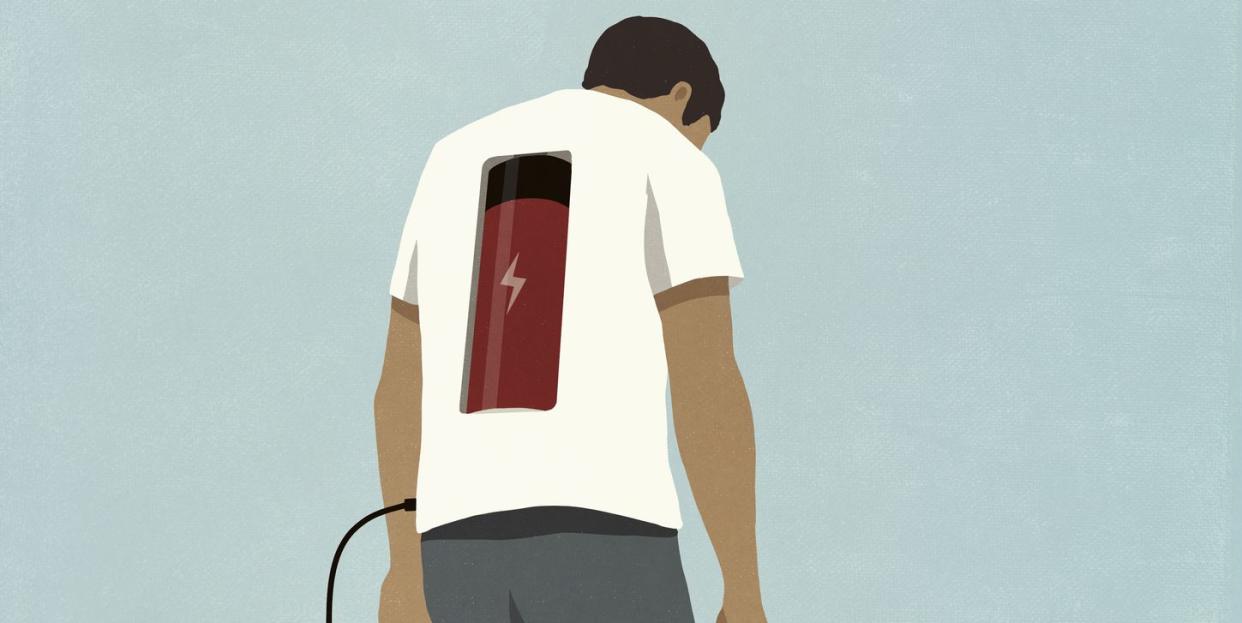Scientists Found a Way to Turn Your Body Into a Battery ... With Your Clothes

Scientists at Nanyang Technological University in Singapore have devised a way to turn your body into a battery through clothing.
A 3-centimeter-by-4-centimeter piece of fabric generated enough energy to power 100 light-emitting diodes for up to five months.
That durability is thanks to a polymer that converts mechanical stress into electricity when it’s pressed, stretched, or squeezed.
Batteries provide energy to electronic devices. Your body generates and uses energy. Ergo, you’re basically a battery.
As you run, walk, or even breathe, your body is moving. A system fine-tuned enough to collect and store that output can transpose it into energy for the electronics we carry with us everyday. The obvious substrate in which to build such a system is our clothes, since they move along with us.
⚡️ You love energy. So do we. Let’s nerd out over it together—join Pop Mech Pro.
But without a series of wires or magnetic coils, how can cotton, wool, polyester, or even leather garments collect, store, and transport electricity? A team at Nanyang Technological University (NTU) in Singapore thinks it has the answers to finally harness your inner generator—and keep you from needing to borrow a charging cord.
Laundry-Proofing the Concept
Human motion powering electrical machinery isn’t new. An arts district in Las Vegas, Nevada already uses the footsteps of passing pedestrians to power its lighting and a nightclub in Glasgow, Scotland announced last year it was going to use the energy from all those dancing bodies to power its heating and cooling systems.
Even power-generating systems in clothing have been around for a while, with tiny wires and circuitry built into the fabric. The downside to these projects so far is that sensitive circuitry doesn’t respond well to being crushed into a drawer or laundered.
But here’s where the NTU team has given the idea of your weekly power walk charging your iPhone a huge shot in the arm: the 3-centimeter-by-4-centimeter piece of fabric that emerged from their proof-of-concept generated enough energy to power 100 light-emitting diodes (LEDs). And after washing, folding, or crumpling the fabric, it continued to perform at the same level for up to five months. A recent paper describing their work appears in the journal Advanced Materials.
It works so well because one of the components of the material is a polymer that converts mechanical stress into electricity when it’s pressed, stretched, or squeezed from the friction when it comes into contact with another surface, like skin. It performs well for so long because its rubber-like behavior makes it strong, flexible, and waterproof.
Building the Battery
To build their body battery, the NTU scientists first screen-printed an electrode pattern on material made up of silver and a chemical called styrene-ethylene-butylene-styrene (SEBS), the basis for a foam-like rubber you might find in bicycle handlebar grips.
The electrode is then attached to a piece of nanofiber made up of ... deep breath ... poly(vinylidene fluoride)-co-hexafluoropropylene (PVDF-HPF), a powerful piezoelectric material, and perovskites, which are calcium titanium oxide minerals. PVDF-HPF produces an electrical charge when stretched or pressed, and perovskite is a crystalline structure scientists have known about for almost two centuries, but has only recently taken off in solar cell and LED research.
The NTU scientists found that embedding perovskites in PVDF-HPF increases the electrical output, and even though perovskites are brittle in nature, they’re made far more durable, stable, and flexible when they’re so tightly enmeshed with PVDF-HPF.
The prototype fabric that came out of the research is set to generate 2.34 watts of electricity per square meter, which is plenty of power to keep your phone or wearable going.
So while the Matrix made it seem like a nightmare, the reality of human batteries could actually be pretty convenient.
You Might Also Like

